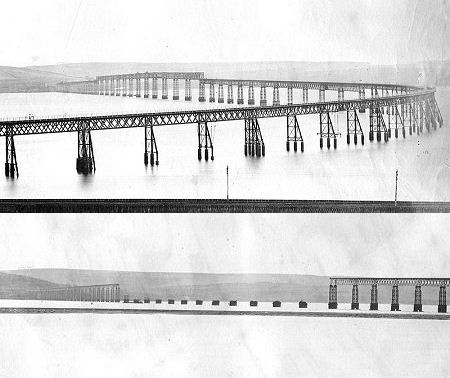 Bouche's Tay Rail Bridge, After Completion and After Collapse Note About Image Copyright |
Sir Thomas Bouch, lived from 25 February 1822 to 30 October 1880. He was an eminent railway engineer best known as the designer of the ill-fated Tay Rail Bridge, which collapsed with the loss of 75 lives on 28 December 1879. The wider picture in Scotland at the time is set out in our Historical Timeline.
Thomas Bouch was born near Carlisle in Cumbria. He was schooled in Carlisle, and after the death of his father in 1838 he took up an engineering apprenticeship in Liverpool. He later found employment as an engineer with a number of the railway companies whose networks were rapidly developing at the time. At the age of 26 he was appointed as Engineer to the Edinburgh and Northern Railway where he made his name by developing the technology needed for the roll-on roll-off railway ferries. He also helped design Edinburgh's Waverley Station.
In 1851 Bouch set up as an independent consultant. Two years later he married Margaret Nelson with whom he had three children. During the 1860s his practice grew from strength to strength and Bouch became one of the country's most respected railway engineers.
In 1870 a Bill was passed by Parliament for a Tay Rail Bridge, to be built to a design by Bouch. His bridge was to be a lattice-grid design, combining cast and wrought iron. Work began on 22 July 1871. As it progressed, however, it became clear that the survey work on the river bed, which had predicted a level depth of bedrock, was wrong. They actually found that in the centre of the river the bedrock was too far below the river bed to be used to bear the weight of the bridge. Bouch responded by substituting lighter bridge piers of iron for the brick piers he had planned, and by reducing the number of bridge piers, increasing the span between each.
When the Tay Rail Bridge opened on 1 June 1878 it as the longest in the world and reduced the journey time between Edinburgh and Dundee by an hour. Queen Victoria, present at the opening, awarded Bouch a knighthood in recognition of his achievement. Another early traveller across the bridge was the recently ex-president of the USA, Ulysses S. Grant He commented that it was a "a big bridge for a small city".
On the evening of 28 December 1879, the central sections of the Tay Rail Bridge collapsed during a violent storm, while a train was crossing. Seventy-five people were killed, including Sir Thomas's son-in-law. A public enquiry into the disaster concluded that the bridge had been "badly designed, badly built, and badly maintained". Problems emerged with the quality of the materials used, and it seems that Bouch's designs may have made no allowance at all for wind loading on the structure.
Sir Thomas Bouch died a few months after the final report of the public enquiry into the disaster was published. He is buried in Dean Cemetery in Edinburgh. At the time of the disaster, work was underway on a railway bridge over the River Forth designed by Bouch. Construction was stopped immediately, and when work on the Forth Bridge restarted in 1883 it was to a completely new and massively stronger design produced by Sir John Fowler and Sir Benjamin Baker. 1883 also saw the start of the building of the second Tay Rail Bridge. This was opened on 13 July 1887 and remains in use today. The Tay Bridge disaster itself was commemorated in by the best known poem of William McGonagall.

